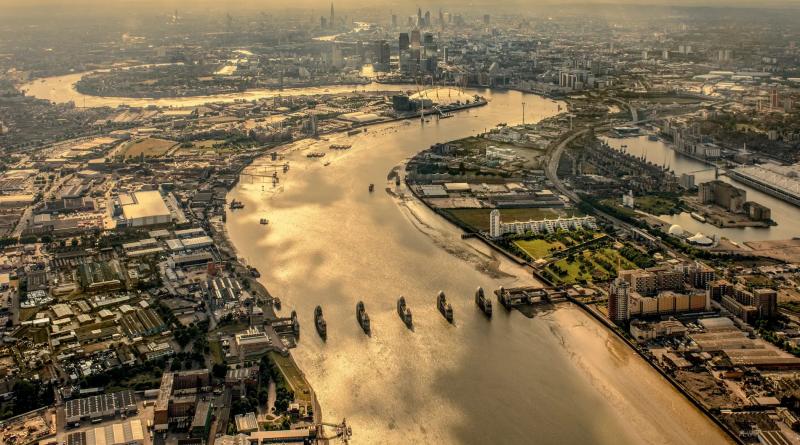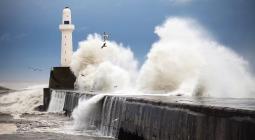Before the flood: how much longer will the Thames Barrier protect London?

The last time the Thames broke its banks and flooded central London was on 7 January 1928, when a storm sent record water levels up the tidal river, from Greenwich and Woolwich in the east as far as Hammersmith in the west. Built on flood plains, the capital was defended only by embankments. The flood waters burst over them into Whitehall and Westminster, and rushed through crowded slums. Fourteen died and thousands were left homeless.
After another catastrophic North Sea storm surge in 1953 caused floods along the east coast of England that were even more deadly – killing 307 people, including 59 at Canvey Island on the Thames estuary – discussion began about how to protect London.
Three decades later, the Thames Barrier was completed. A colossal engineering project, it spans 520 metres (1,700ft) of river near Woolwich and has so far protected 1.4 million Londoners (and about £320bn worth of properties) from more than 100 tidal floods.The ocean, however, is rising. With sea levels forecast to creep up by as much as a metre by 2100, and more extreme weather expected in a warming world, the Environment Agency (EA) says tidal defences upstream of the barrier must be raised by 2050 – 15 years earlier than expected. It cited “heightened risk of flooding” from rising sea levels.
The ocean, however, is rising. With sea levels forecast to creep up by as much as a metre by 2100, and more extreme weather expected in a warming world, the Environment Agency (EA) says tidal defences upstream of the barrier must be raised by 2050 – 15 years earlier than expected. It cited “heightened risk of flooding” from rising sea levels.The ocean, however, is rising. With sea levels forecast to creep up by as much as a metre by 2100, and more extreme weather expected in a warming world, the Environment Agency (EA) says tidal defences upstream of the barrier must be raised by 2050 – 15 years earlier than expected. It cited “heightened risk of flooding” from rising sea levels.
The EA acknowledges flooding will increase unless something is done – which it says the new plan addresses by including measures to reduce the strain on the barrier. The minister responsible for flood defences, Rebecca Pow, described the Thames Estuary 2100 plan as a “world-leading climate adaptation strategy”.
But the EA’s own guidance also says the barrier should not be closed more than 50 times a year. If 50 becomes the norm, it says, the barrier could fail. The barrier was closed four times in the 1980s, 35 times in the 1990s, 75 times in the 2000s and 74 times in the 2010s.
The EA acknowledges flooding will increase unless something is done – which it says the new plan addresses by including measures to reduce the strain on the barrier. The minister responsible for flood defences, Rebecca Pow, described the Thames Estuary 2100 plan as a “world-leading climate adaptation strategy”.
But the EA’s own guidance also says the barrier should not be closed more than 50 times a year. If 50 becomes the norm, it says, the barrier could fail. The barrier was closed four times in the 1980s, 35 times in the 1990s, 75 times in the 2000s and 74 times in the 2010s.
The EA acknowledges flooding will increase unless something is done – which it says the new plan addresses by including measures to reduce the strain on the barrier. The minister responsible for flood defences, Rebecca Pow, described the Thames Estuary 2100 plan as a “world-leading climate adaptation strategy”.
But the EA’s own guidance also says the barrier should not be closed more than 50 times a year. If 50 becomes the norm, it says, the barrier could fail. The barrier was closed four times in the 1980s, 35 times in the 1990s, 75 times in the 2000s and 74 times in the 2010s.
The EA acknowledges flooding will increase unless something is done – which it says the new plan addresses by including measures to reduce the strain on the barrier. The minister responsible for flood defences, Rebecca Pow, described the Thames Estuary 2100 plan as a “world-leading climate adaptation strategy”.
But the EA’s own guidance also says the barrier should not be closed more than 50 times a year. If 50 becomes the norm, it says, the barrier could fail. The barrier was closed four times in the 1980s, 35 times in the 1990s, 75 times in the 2000s and 74 times in the 2010s.
The EA acknowledges flooding will increase unless something is done – which it says the new plan addresses by including measures to reduce the strain on the barrier. The minister responsible for flood defences, Rebecca Pow, described the Thames Estuary 2100 plan as a “world-leading climate adaptation strategy”.
But the EA’s own guidance also says the barrier should not be closed more than 50 times a year. If 50 becomes the norm, it says, the barrier could fail. The barrier was closed four times in the 1980s, 35 times in the 1990s, 75 times in the 2000s and 74 times in the 2010s.
“If you continue to close it for fluvial closures, then the barrier will come to the end of its life by 2030 or 2035,” says Haigh. “They plan to reduce the number of closures by half and reduce forecasting error. If they can do these two things, they can keep the number of closures below 50 a year.
“If they stop the fluvial closures, reduce forecasting error and at some point raise the defences in London, I’m fairly confident they can keep the barrier until 2050 or 2060.”
An EA spokesperson says the Thames Estuary 2100 plan “takes account of a range of possible climate futures”. They say the agency has used the “higher scenario” of sea level rise from the UK’s official climate projections from 2018.
The spokesperson says: “We are committed to reappraising our options ahead of the next review in 2030 and this may result in some being removed if they are no longer economically or technically viable. A final decision will be taken by 2040 to ensure that an upgraded or new Thames Barrier can be built and operational in time for 2070.”
Cloke sees the timescale differently, noting that it took 31 years to build the barrier after the 1953 flood. “This wait-and-see attitude, it’s a bit like building a house and not putting a roof on it to wait and see if it rains,” she says. “We could do something about it now. It’s so shortsighted.”





